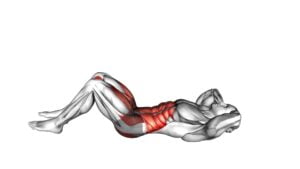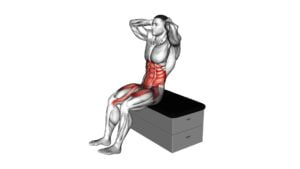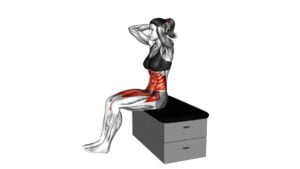Air Twisting Crunch (VERSION 2) (male) – Video Exercise Guide & Tips

Looking to tone your abs and strengthen your core? Check out the Air Twisting Crunch (Version 2) in this video exercise guide.
Watch This Exercise Video
This male-focused workout will guide you through proper form and technique, as well as provide modifications for beginners and advanced variations for experienced individuals.
Avoid common mistakes and maximize the effectiveness of this exercise with our helpful tips.
Get ready to twist and crunch your way to a stronger, fitter you!
Key Takeaways
- The Air Twisting Crunch is highly effective for building core strength and targeting abdominal muscles, obliques, and deeper core muscles.
- Proper form and technique include initiating the movement from the core, avoiding using momentum, and practicing effective breathing.
- Beginners can modify the exercise by reducing the range of motion, using hands for support, and progressing at their own pace.
- Advanced variations for experienced individuals include the Russian Twist with Medicine Ball, Hanging Air Twisting Crunch, and Weighted Air Twisting Crunch.
Benefits of the Air Twisting Crunch
Get ready to experience the amazing benefits of the Air Twisting Crunch. This exercise is highly effective for building core strength and targeting your abdominal muscles. By incorporating twisting motions into the traditional crunch, you engage not only your rectus abdominis, but also your obliques and deeper core muscles.
The Air Twisting Crunch is a dynamic exercise that requires you to lie on your back with your knees bent and feet flat on the floor. As you crunch up, you simultaneously rotate your torso to one side, reaching your opposite elbow towards your knee. This twisting motion engages your obliques, helping to sculpt those coveted side abs.
In addition to toning your abdominal muscles, the Air Twisting Crunch also improves your core strength. Your core acts as a stabilizer for your entire body, and a strong core can enhance your overall fitness and performance in other activities. By regularly incorporating this exercise into your routine, you can develop a strong and stable core, which can improve your posture, balance, and overall athletic performance.
Now that you understand the benefits of the Air Twisting Crunch, let's move on to discussing the proper form and technique for this exercise.
Proper Form and Technique for the Exercise
To perform the Air Twisting Crunch with proper form and technique, you should position yourself on your back with your knees bent and feet flat on the floor. Place your hands lightly behind your head, keeping your elbows out to the sides. Engage your core muscles by drawing your belly button towards your spine.
One of the most common errors people make when performing the Air Twisting Crunch is using their neck muscles instead of their abdominal muscles. It's important to remember to initiate the movement from your core, not your neck. Another common mistake is using momentum to swing your body up instead of relying on your abdominal strength. This can lead to ineffective results and potential strain on your neck and back.
In addition to maintaining proper form, effective breathing is crucial during the Air Twisting Crunch. Exhale as you lift your upper body off the ground and twist towards one side, and inhale as you lower back down to the starting position. This helps to engage your deep core muscles and promote a controlled movement.
Modifications for Beginners
If you're new to the Air Twisting Crunch exercise, there are modifications you can make to simplify the movement.
By starting with easier variations, such as reducing the range of motion or using less resistance, you can gradually build up your strength and technique.
It's important to progress at your own pace and listen to your body to avoid injury.
Simplified Exercise Variations
Start with a modified version of the Air Twisting Crunch to make it easier for beginners. Here are some exercise modifications to help you get started:
- Reduce the range of motion: Instead of twisting all the way to the side, twist only halfway.
- Use your hands for support: Place your hands behind your head or on your thighs to provide additional support and stability.
- Slow down the movement: Perform the exercise at a slower pace, focusing on engaging your core muscles throughout the movement.
By incorporating these modifications, you can gradually build up your strength and technique before progressing to more advanced techniques.
Remember to listen to your body and only progress when you feel comfortable and confident.
Gradual Intensity Progression
As you progress in your fitness journey, you can gradually increase the intensity of the Air Twisting Crunch by implementing modifications specifically designed for beginners. These progression techniques will help you challenge your muscles and increase the difficulty of the exercise over time.
One modification you can try is to start with smaller twisting motions and gradually increase the range of motion as your core strength improves.
Another modification is to perform the exercise with your feet on the ground instead of lifting them off, which provides more stability and makes it easier to maintain proper form.
Additionally, you can use a lighter weight or no weight at all, and gradually increase the resistance as you get stronger.
Remember to listen to your body and progress at a pace that feels comfortable for you.
Advanced Variations for Experienced Individuals
To challenge yourself further, try incorporating more dynamic movements into your Air Twisting Crunch routine. These advanced variations are designed specifically for experienced individuals who are looking for an extra challenge in their core workout. Here are three options to take your abdominal workout to the next level:
- Russian Twist with Medicine Ball: Hold a medicine ball in your hands while performing the Air Twisting Crunch. As you twist your torso, pass the medicine ball from one hand to the other, adding an additional level of resistance and coordination to the exercise.
- Hanging Air Twisting Crunch: Hang from a pull-up bar and perform the Air Twisting Crunch while suspended in the air. This variation increases the difficulty by engaging your upper body strength as well as your core muscles, providing a comprehensive workout for your entire upper body.
- Weighted Air Twisting Crunch: Hold a dumbbell or kettlebell in your hands while performing the Air Twisting Crunch. The added weight challenges your core muscles even more, helping to build strength and definition in your abs.
Incorporating these advanced variations into your Air Twisting Crunch routine will push your limits and help you achieve new levels of strength and fitness. Remember to start with lighter weights and progress gradually as you become more comfortable with the exercises.
Common Mistakes to Avoid
To ensure you perform the air twisting crunch correctly, there are a few common mistakes you should avoid.
First, pay attention to your arm positioning. Keep your arms extended and parallel to the ground throughout the exercise, avoiding any unnecessary bending or twisting.
Additionally, make sure you maintain proper breathing technique, exhaling as you twist your torso and inhaling as you return to the starting position.
Arm Positioning Errors
Avoid making the mistake of positioning your arms incorrectly during the Air Twisting Crunch exercise. Proper arm positioning is crucial for maximizing the effectiveness of this exercise and preventing potential injuries.
Here are some common arm mistakes to avoid and tips on how to correct your arm positioning:
- Crossing your arms over your chest: This reduces the engagement of your core muscles and puts unnecessary strain on your neck. Instead, keep your arms extended straight out in front of you.
- Placing your hands behind your head: This can lead to pulling on your neck, causing discomfort or even injury. Instead, lightly place your fingertips behind your ears, keeping your elbows wide.
- Holding your arms too close to your body: This limits your range of motion and decreases the challenge for your abdominal muscles. Instead, extend your arms out to the sides, parallel to the floor.
Breathing Technique Mistakes
Ensure optimal results and prevent potential errors by focusing on proper breathing technique during the Air Twisting Crunch exercise.
Proper breathing technique is crucial for maximizing the effectiveness of this exercise and avoiding common breathing mistakes.
One common mistake is holding your breath during the movement. Remember to inhale deeply through your nose as you prepare for the crunch and exhale forcefully through your mouth as you perform the twisting motion.
Another mistake is shallow breathing, which can restrict oxygen flow and diminish the intensity of the exercise. Make sure to take deep breaths, filling your lungs completely, to ensure sufficient oxygen supply to your muscles.
Tips for Maximizing the Effectiveness of the Exercise
Engage your core muscles throughout the entire exercise for maximum effectiveness. Here are some tips to help you maximize the effectiveness of the Air Twisting Crunch:
- Maintain proper form: It's important to keep your back straight and your shoulders relaxed throughout the exercise. Avoid arching your back or straining your neck, as this can lead to injury and reduce the effectiveness of the exercise.
- Control your movements: Make sure to perform the exercise in a slow and controlled manner. Rushing through the repetitions can compromise your form and reduce the engagement of your core muscles.
- Focus on the twist: The twisting motion is the key component of this exercise. Be mindful of your range of motion and focus on rotating your torso from side to side, using your core muscles to initiate the movement.
- Avoid holding your breath: Many people tend to hold their breath during abdominal exercises. Remember to breathe continuously throughout the exercise, inhaling during the starting position and exhaling as you twist your torso.
- Gradually increase intensity: As you become more comfortable with the exercise, you can add resistance by holding a weight plate or dumbbell against your chest. This will challenge your core muscles even further and enhance the effectiveness of the exercise.
Frequently Asked Questions
How Many Sets and Reps Should I Do for the Air Twisting Crunch?
For the air twisting crunch, it's important to focus on your breathing technique. Take a deep breath in as you twist your torso, and exhale as you come back to the starting position. This will help engage your core muscles effectively.
As for sets and reps, it depends on your fitness level and goals. Beginners can start with 2-3 sets of 10-12 reps, while advanced individuals can increase to 3-4 sets of 15-20 reps. Remember to listen to your body and adjust accordingly.
Can I Do the Air Twisting Crunch if I Have a Lower Back Injury?
If you have a lower back injury, it's important to prioritize your recovery and avoid exercises that may aggravate the injury.
The air twisting crunch may put strain on your lower back, so it's best to opt for alternative core workouts that are gentle and won't exacerbate your condition.
Consult with a healthcare professional or physical therapist to get personalized recommendations and find recovery exercises that are safe and effective for you.
Is It Necessary to Use a Mat or Can I Perform the Exercise on a Hard Surface?
When it comes to the air twisting crunch, it isn't necessary to use a mat, but it's highly recommended. Using a mat provides several benefits for your exercise routine.
It offers cushioning and support for your body, especially your lower back, reducing the risk of injury. Additionally, a mat provides a non-slip surface, ensuring stability and proper form during the exercise.
If you don't have a mat, you can modify the exercise by placing a folded towel or blanket on the floor for added comfort.
How Long Should I Rest Between Sets of Air Twisting Crunches?
To ensure proper form and avoid injury, it's crucial to know how long to rest between sets of air twisting crunches. Rest periods will vary depending on your fitness level and goals. Generally, it's recommended to take 30-90 seconds of rest between sets.
This allows your muscles to recover and recharge, maximizing the effectiveness of the exercise. Remember to listen to your body and adjust the rest period as needed.
Can I Incorporate Weights or Resistance Bands Into the Air Twisting Crunch for Added Intensity?
Yes, you can definitely incorporate weights or resistance bands into the air twisting crunch for added intensity. Adding weights will increase the resistance and challenge your muscles even more, helping to build strength and definition.
Resistance bands can provide a different type of resistance, targeting your muscles in a unique way. Both options can enhance the effectiveness of the exercise and help you achieve your fitness goals faster.
Conclusion
In conclusion, the air twisting crunch is a highly effective exercise for strengthening the core and improving overall stability.
By following proper form and technique, beginners and experienced individuals can benefit from this exercise.
It's important to avoid common mistakes and make modifications as needed.
By maximizing the effectiveness of the exercise, individuals can achieve their fitness goals and enhance their overall physical well-being.

Author
Years ago, the spark of my life’s passion ignited in my mind the moment I stepped into the local gym for the first time. The inaugural bead of perspiration, the initial endeavor, the very first surge of endorphins, and a sense of pride that washed over me post-workout marked the beginning of my deep-seated interest in strength sports, fitness, and sports nutrition. This very curiosity blossomed rapidly into a profound fascination, propelling me to earn a Master’s degree in Physical Education from the Academy of Physical Education in Krakow, followed by a Sports Manager diploma from the Jagiellonian University. My journey of growth led me to gain more specialized qualifications, such as being a certified personal trainer with a focus on sports dietetics, a lifeguard, and an instructor for wellness and corrective gymnastics. Theoretical knowledge paired seamlessly with practical experience, reinforcing my belief that the transformation of individuals under my guidance was also a reflection of my personal growth. This belief holds true even today. Each day, I strive to push the boundaries and explore new realms. These realms gently elevate me to greater heights. The unique combination of passion for my field and the continuous quest for growth fuels my drive to break new ground.







